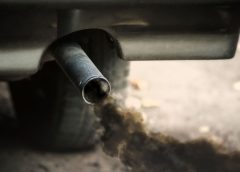
New Cheap Carbon Capture Tech Could Be Attached To Tailpipes
[ad_1]

The technology is scalable enough to be used on vehicles exhausts and other movable sources of carbon dioxide. Image credit: nampix/Shutterstock.com
Researchers have discovered a method of capturing carbon dioxide from fossil fuel burning using cheap and simple chemicals already used in industry. The team believes that the approach is scalable in a way that could not only be used on top of industrial chimneys, but also on vehicles exhausts and other movable sources of carbon dioxide.
The breakthrough, reported in Science Advances, used melamine, a polymer that is the main component of Formica, a type of laminated composite material. The melamine was combined with diethylenetriamine and cyanuric acid (commercially available chemicals) and was treated with formaldehyde, which created nanoscale pores on the polymer.
The result is the creation of a material that could absorb almost all the carbon dioxide in a flue gas mixture within about three minutes. The system works at a temperature of 40°C (104°F) and doesn’t release carbon dioxide until its heated to 80°C (176°F).

Schematic view of carbon dioxide getting captured in the material. Image credit: Haiyan Mao and Jeffrey Reimer, UC Berkeley
“In this study, we focused on cheaper material design for capture and storage and elucidating the interaction mechanism between CO2 and the material,” lead author Dr Haiyan Mao from UC Berkeley said in a statement.
“This work creates a general industrialization method towards sustainable CO2 capture using porous networks. We hope we can design a future attachment for capturing car exhaust gas, or maybe an attachment to a building or even a coating on the surface of furniture.”
The team is continuing to tweak the composition of this polymer to create an even more efficient system. The goal is to have an effective, scalable, recyclable, high-capacity carbon-dioxide capture system. Achieving that might be a game changer for reducing greenhouse gas emissions.
[ad_2]
Source link


